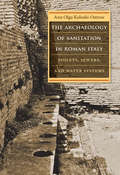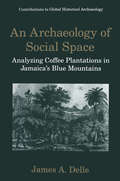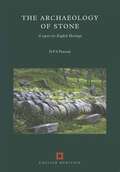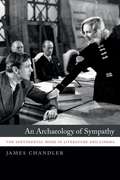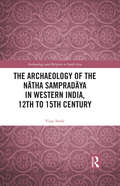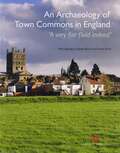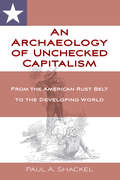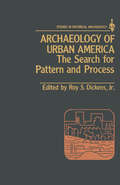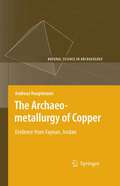- Table View
- List View
The Archaeology of Sacred Spaces: The temple in western India, 2nd century BCE–8th century CE (Archaeology and Religion in South Asia)
by Susan Verma Mishra Himanshu Prabha RayThis volume focuses on the religious shrine in western India as an institution of cultural integration in the period spanning 200 BCE to 800 CE. It presents an analysis of religious architecture at multiple levels, both temporal and spatial, and distinguishes it as a ritual instrument that integrates individuals and communities into a cultural fabric. The work shows how these structures emphasise on communication with a host of audiences such as the lay worshipper, the ritual specialist, the royalty and the elite as well as the artisan and the sculptor. It also examines religious imagery, inscriptions, traditional lore and Sanskrit literature. The book will be of special interest to researchers and scholars of ancient Indian history, Hinduism, religious studies, architecture and South Asian studies.
The Archaeology of Sacred Spaces: The temple in western India, 2nd century BCE–8th century CE (Archaeology and Religion in South Asia)
by Susan Verma Mishra Himanshu Prabha RayThis volume focuses on the religious shrine in western India as an institution of cultural integration in the period spanning 200 BCE to 800 CE. It presents an analysis of religious architecture at multiple levels, both temporal and spatial, and distinguishes it as a ritual instrument that integrates individuals and communities into a cultural fabric. The work shows how these structures emphasise on communication with a host of audiences such as the lay worshipper, the ritual specialist, the royalty and the elite as well as the artisan and the sculptor. It also examines religious imagery, inscriptions, traditional lore and Sanskrit literature. The book will be of special interest to researchers and scholars of ancient Indian history, Hinduism, religious studies, architecture and South Asian studies.
The Archaeology of Sanitation in Roman Italy: Toilets, Sewers, and Water Systems (Studies in the History of Greece and Rome)
by Ann Olga Koloski-OstrowThe Romans developed sophisticated methods for managing hygiene, including aqueducts for moving water from one place to another, sewers for removing used water from baths and runoff from walkways and roads, and public and private latrines. Through the archeological record, graffiti, sanitation-related paintings, and literature, Ann Olga Koloski-Ostrow explores this little-known world of bathrooms and sewers, offering unique insights into Roman sanitation, engineering, urban planning and development, hygiene, and public health. Focusing on the cities of Pompeii, Herculaneum, Ostia, and Rome, Koloski-Ostrow's work challenges common perceptions of Romans' social customs, beliefs about health, tolerance for filth in their cities, and attitudes toward privacy. In charting the complex history of sanitary customs from the late republic to the early empire, Koloski-Ostrow reveals the origins of waste removal technologies and their implications for urban health, past and present.
The Archaeology of Seeing: Science and Interpretation, the Past and Contemporary Visual Art
by Liliana JanikThe Archaeology of Seeing provides readers with a new and provocative understanding of material culture through exploring visual narratives captured in cave and rock art, sculpture, paintings, and more. The engaging argument draws on current thinking in archaeology, on how we can interpret the behaviour of people in the past through their use of material culture, and how this affects our understanding of how we create and see art in the present. Exploring themes of gender, identity, and story-telling in visual material culture, this book forces a radical reassessment of how the ability to see makes us and our ancestors human; as such, it will interest lovers of both art and archaeology. Illustrated with examples from around the world, from the earliest art from hundreds of thousands of years ago, to the contemporary art scene, including street art and advertising, Janik cogently argues that the human capacity for art, which we share with our most ancient ancestors and cousins, is rooted in our common neurophysiology. The ways in which our brains allow us to see is a common heritage that shapes the creative process; what changes, according to time and place, are the cultural contexts in which art is produced and consumed. The book argues for an innovative understanding of art through the interplay between the way the human brain works and the culturally specific creation and interpretation of meaning, making an important contribution to the debate on art/archaeology.
The Archaeology of Seeing: Science and Interpretation, the Past and Contemporary Visual Art
by Liliana JanikThe Archaeology of Seeing provides readers with a new and provocative understanding of material culture through exploring visual narratives captured in cave and rock art, sculpture, paintings, and more. The engaging argument draws on current thinking in archaeology, on how we can interpret the behaviour of people in the past through their use of material culture, and how this affects our understanding of how we create and see art in the present. Exploring themes of gender, identity, and story-telling in visual material culture, this book forces a radical reassessment of how the ability to see makes us and our ancestors human; as such, it will interest lovers of both art and archaeology. Illustrated with examples from around the world, from the earliest art from hundreds of thousands of years ago, to the contemporary art scene, including street art and advertising, Janik cogently argues that the human capacity for art, which we share with our most ancient ancestors and cousins, is rooted in our common neurophysiology. The ways in which our brains allow us to see is a common heritage that shapes the creative process; what changes, according to time and place, are the cultural contexts in which art is produced and consumed. The book argues for an innovative understanding of art through the interplay between the way the human brain works and the culturally specific creation and interpretation of meaning, making an important contribution to the debate on art/archaeology.
An Archaeology of Social Space: Analyzing Coffee Plantations in Jamaica’s Blue Mountains (Contributions To Global Historical Archaeology)
by James A. DelleJames Delle has solved a number of problems in Caribbean archaeology with An Archaeology of Social Space. He deals with most of the problems by using historical archaeology, and clearly implicates Ameri canist prehistorians. Although this book is about coffee plantations in the Blue Mountains area of Jamaica, it is actually about the whole Caribbean. Just as it is about all archaeology, not only historical archaeology, it is also a book about colonialism and national inde pendence and how these two enormous events happened in the context of eighteenth and nineteenth century capitalism. The first issue raised appears to be an academic topic that has come to be known as landscape archaeology. Landscape archaeology considers the planned spaces around living places. The topic is big, comprehensive, and new within historical archaeology. Its fundamen tal insight is that in the early modern and modern worlds everything within view could be made into money. Seeing occurs in space and from 1450, or a little before, everything that could be seen could, potentially, be measured. The measuring-and the accompanying culture of record ing called a scriptural economy-became a way of controlling people in space, for a profit. Dr. Delle thus explores maps, local philosophies of settlement, town dwelling, housing, and the actual condition of plantations and their buildings now, so as to describe coffee-Jamaica from 1790-1860.
The Archaeology of Stone: A report for English Heritage (English Heritage)
by D P PeacockEnglish Heritage's 'Exploring our past' (1991) identified stone in archaeology as a problem area: 'The sources, manufacture and distribution of stone artifacts remain poorly understood, whether these are the cutting tools of prehistory, such as axes and knives, or grinding implements such as hones and querns'. It further states that a commissioned assessment of stone in archaeology should identify basic recording standards, guidelines for processing, shortcomings in regional and local sequences, and potential themes for future study. 'The archaeology of stone' is the result of this commissioned report. Considering all types of stone other than flint, which is considered a special case, and using a combination of library work, site visits, and interviews with practitioners, Professor Peacock's report considers retention and processing policies, evaluates the needs of stone identification and provenancing, and examines ways of recording technological traces of stone working or use. In addition to stone axes, hones, and querns, a major area of concern is with building materials, where sheer quantities often overwhelm even the most smoothly run operations. In addition, consideration of standing buildings helps to put excavated material into a wider context. He concludes with recommendations that point to areas where more research and evaluation are needed, based firmly on the necessary condition that any changes to current practices must be demonstrably useful, and lead to a substantially better understanding of the past.
The Archaeology of Sutton Park
by Michael HodderSutton Park is one of the largest urban parks in Europe. It was always set apart as ‘special’ and remains so, as a large and well-used public park. Its creation as a deer park in the twelfth century preserved the past and created the present. Detailed study of extensive earthworks, combined with excavation, documentary research, palaeo-environmental evidence and the results of LiDAR survey, shows how the landscape was shaped and managed by people living in and around it, travelling through it, or hunting in it, and demonstrates how its present vegetation patterns result from past uses. In addition to the boundary, subdivisions and fishponds of the medieval deer park, its archaeological features include prehistoric burnt mounds and a Roman road, and prominent remains of later uses including woodland management, water-powered industries, military training, sport and recreation. In addition, this book discusses management of the park to protect its landscape for the future, and an appendix highlights particular features to visit.
An Archaeology of Sympathy: The Sentimental Mode in Literature and Cinema
by James ChandlerIn the middle of the eighteenth century, something new made itself felt in European culture—a tone or style that came to be called the sentimental. The sentimental mode went on to shape not just literature, art, music, and cinema, but people’s very structures of feeling, their ways of doing and being. In what is sure to become a critical classic, An Archaeology of Sympathy challenges Sergei Eisenstein’s influential account of Dickens and early American film by tracing the unexpected history and intricate strategies of the sentimental mode and showing how it has been reimagined over the past three centuries. James Chandler begins with a look at Frank Capra and the Capraesque in American public life, then digs back to the eighteenth century to examine the sentimental substratum underlying Dickens and early cinema alike. With this surprising move, he reveals how literary spectatorship in the eighteenth century anticipated classic Hollywood films such as Capra’s It Happened One Night, Mr. Deeds Goes to Town, and It’s a Wonderful Life. Chandler then moves forward to romanticism and modernism—two cultural movements often seen as defined by their rejection of the sentimental—examining how authors like Mary Shelley, Joseph Conrad, James Joyce, and Virginia Woolf actually engaged with sentimental forms and themes in ways that left a mark on their work. Reaching from Laurence Sterne to the Coen brothers, An Archaeology of Sympathy casts new light on the long eighteenth century and the novelistic forebears of cinema and our modern world.
An Archaeology of Sympathy: The Sentimental Mode in Literature and Cinema
by James ChandlerIn the middle of the eighteenth century, something new made itself felt in European culture—a tone or style that came to be called the sentimental. The sentimental mode went on to shape not just literature, art, music, and cinema, but people’s very structures of feeling, their ways of doing and being. In what is sure to become a critical classic, An Archaeology of Sympathy challenges Sergei Eisenstein’s influential account of Dickens and early American film by tracing the unexpected history and intricate strategies of the sentimental mode and showing how it has been reimagined over the past three centuries. James Chandler begins with a look at Frank Capra and the Capraesque in American public life, then digs back to the eighteenth century to examine the sentimental substratum underlying Dickens and early cinema alike. With this surprising move, he reveals how literary spectatorship in the eighteenth century anticipated classic Hollywood films such as Capra’s It Happened One Night, Mr. Deeds Goes to Town, and It’s a Wonderful Life. Chandler then moves forward to romanticism and modernism—two cultural movements often seen as defined by their rejection of the sentimental—examining how authors like Mary Shelley, Joseph Conrad, James Joyce, and Virginia Woolf actually engaged with sentimental forms and themes in ways that left a mark on their work. Reaching from Laurence Sterne to the Coen brothers, An Archaeology of Sympathy casts new light on the long eighteenth century and the novelistic forebears of cinema and our modern world.
An Archaeology of Sympathy: The Sentimental Mode in Literature and Cinema
by James ChandlerIn the middle of the eighteenth century, something new made itself felt in European culture—a tone or style that came to be called the sentimental. The sentimental mode went on to shape not just literature, art, music, and cinema, but people’s very structures of feeling, their ways of doing and being. In what is sure to become a critical classic, An Archaeology of Sympathy challenges Sergei Eisenstein’s influential account of Dickens and early American film by tracing the unexpected history and intricate strategies of the sentimental mode and showing how it has been reimagined over the past three centuries. James Chandler begins with a look at Frank Capra and the Capraesque in American public life, then digs back to the eighteenth century to examine the sentimental substratum underlying Dickens and early cinema alike. With this surprising move, he reveals how literary spectatorship in the eighteenth century anticipated classic Hollywood films such as Capra’s It Happened One Night, Mr. Deeds Goes to Town, and It’s a Wonderful Life. Chandler then moves forward to romanticism and modernism—two cultural movements often seen as defined by their rejection of the sentimental—examining how authors like Mary Shelley, Joseph Conrad, James Joyce, and Virginia Woolf actually engaged with sentimental forms and themes in ways that left a mark on their work. Reaching from Laurence Sterne to the Coen brothers, An Archaeology of Sympathy casts new light on the long eighteenth century and the novelistic forebears of cinema and our modern world.
An Archaeology of Sympathy: The Sentimental Mode in Literature and Cinema
by James ChandlerIn the middle of the eighteenth century, something new made itself felt in European culture—a tone or style that came to be called the sentimental. The sentimental mode went on to shape not just literature, art, music, and cinema, but people’s very structures of feeling, their ways of doing and being. In what is sure to become a critical classic, An Archaeology of Sympathy challenges Sergei Eisenstein’s influential account of Dickens and early American film by tracing the unexpected history and intricate strategies of the sentimental mode and showing how it has been reimagined over the past three centuries. James Chandler begins with a look at Frank Capra and the Capraesque in American public life, then digs back to the eighteenth century to examine the sentimental substratum underlying Dickens and early cinema alike. With this surprising move, he reveals how literary spectatorship in the eighteenth century anticipated classic Hollywood films such as Capra’s It Happened One Night, Mr. Deeds Goes to Town, and It’s a Wonderful Life. Chandler then moves forward to romanticism and modernism—two cultural movements often seen as defined by their rejection of the sentimental—examining how authors like Mary Shelley, Joseph Conrad, James Joyce, and Virginia Woolf actually engaged with sentimental forms and themes in ways that left a mark on their work. Reaching from Laurence Sterne to the Coen brothers, An Archaeology of Sympathy casts new light on the long eighteenth century and the novelistic forebears of cinema and our modern world.
Archaeology of the Central Mississippi Valley
by Dan F. Morse Phyllis A. MorseArchaeology of the Central Mississippi Valley describes an archeological reconstruction of the preceding 11,000 years of an extraordinarily rich environment centered within the largest river system north of the Amazon. This book focuses on the lowlands of the Mississippi Valley from just north of the Ohio River to the mouth of the Arkansas River.Organized into 13 chapters, this book begins with an overview of the territory between the Ohio and Arkansas rivers. This text then attempts to humanize the archeological interpretations by reference to social organization, settlement system, economy, religion, and politics. Other chapters focus on understanding the nature of change through time in the Central Mississippi Valley. This book discusses as well the difference between an old braided stream surface and the younger meander belt system. The final chapter deals with the investigation of prehistoric Indian remains.This book is a valuable resource for archeologists, zoologists, and scientific hobbyists.
The Archaeology Of The New Testament: The Mediterranean World Of The Early Christian Apostles
by Jack FineganThe Archeology of the New Testament is the authoritative illustrated account of what is presently known about the chief sites and monuments connected with the life of Jesus and the history of the early church. To follow the order of the New Testament, it first investigates sites connected with John the Baptist and then proceeds to Bethlehem and
The Archaeology Of The New Testament: The Mediterranean World Of The Early Christian Apostles (Routledge Library Editions: Archaeology Ser.)
by Jack FineganThe Archeology of the New Testament is the authoritative illustrated account of what is presently known about the chief sites and monuments connected with the life of Jesus and the history of the early church. To follow the order of the New Testament, it first investigates sites connected with John the Baptist and then proceeds to Bethlehem and
The Archaeology of the Nātha Sampradāya in Western India, 12th to 15th Century (Archaeology and Religion in South Asia)
by Vijay SardeThis book studies Nātha sampradāya through archaeological evidence for the first time. Drawing on a pioneering approach to the study of ascetic traditions, it investigates not only the nature of the Nātha sampradāya’s religious architecture but also examines the extent to which they shared space with other religious groups such as the devotees of Siva and Sakti, Buddhism, and Islam, especially with the Sufi tradition. Focusing on western India, the book sifts through a variety of archaeological evidence and documentation of their temples, caves, and maṭhas. It critically analyses iconographic representations of ascetics on temple walls and sculptural representations of yogic postures or āsanas. Further, these representations are discussed within a pan-South Asian framework to highlight both the commonalities of the tradition across the subcontinent and the regional specificities, along with their chronological spread. Breaking new ground, this volume will be of great interest to scholars and researchers of religion, especially Hinduism, history, archaeology, and South Asian studies.
The Archaeology of the Nātha Sampradāya in Western India, 12th to 15th Century (Archaeology and Religion in South Asia)
by Vijay SardeThis book studies Nātha sampradāya through archaeological evidence for the first time. Drawing on a pioneering approach to the study of ascetic traditions, it investigates not only the nature of the Nātha sampradāya’s religious architecture but also examines the extent to which they shared space with other religious groups such as the devotees of Siva and Sakti, Buddhism, and Islam, especially with the Sufi tradition. Focusing on western India, the book sifts through a variety of archaeological evidence and documentation of their temples, caves, and maṭhas. It critically analyses iconographic representations of ascetics on temple walls and sculptural representations of yogic postures or āsanas. Further, these representations are discussed within a pan-South Asian framework to highlight both the commonalities of the tradition across the subcontinent and the regional specificities, along with their chronological spread. Breaking new ground, this volume will be of great interest to scholars and researchers of religion, especially Hinduism, history, archaeology, and South Asian studies.
Archaeology of the Political Unconscious: Theater and Opera in East Berlin, 1967–1977 (ISSN)
by Jennifer WilliamsThis book investigates the aesthetic and political dialectics of East Berlin to argue how its theater and opera stages incited artists to act out, fuel, and resist the troubled construction of political legitimacy.This volume investigates three case studies of how leading East Berlin stages excavated fragmentary materials from Weimar dramatist Bertolt Brecht’s oeuvre and repurposed them for their post‑fascist society: Uta Birnbaum’s 1967 Man Equals Man at the Berliner Ensemble, Joachim Herz’s 1977 Rise and Fall of the City of Mahagonny at the Komische Oper, and Heiner Muller’s own productions of his trailblazing plays. In each instance, reused theatrical artifacts dialectically expressed the contradictions inherent in East German political legitimacy, at once amplifying and critiquing it. Illuminated by original archival research and translations of letters and artistic ephemera published in English for the first time, and engaging with alternative East German feminist epistemologies, this book’s critical investigation of culture and political legitimacy in the shadow of Germany’s fascist past resonates beyond the Iron Curtain into the twenty‑first century. Its final chapter examines how performative artifacts influence the process of political legitimation in more recent history, ranging from Checkpoint Charlie tourism to the January 6, 2021 US insurrection.This study will be of great interest to students and scholars in theater and performance studies, art history, musicology, German studies, anthropology, and political science.
Archaeology of the Political Unconscious: Theater and Opera in East Berlin, 1967–1977 (ISSN)
by Jennifer WilliamsThis book investigates the aesthetic and political dialectics of East Berlin to argue how its theater and opera stages incited artists to act out, fuel, and resist the troubled construction of political legitimacy.This volume investigates three case studies of how leading East Berlin stages excavated fragmentary materials from Weimar dramatist Bertolt Brecht’s oeuvre and repurposed them for their post‑fascist society: Uta Birnbaum’s 1967 Man Equals Man at the Berliner Ensemble, Joachim Herz’s 1977 Rise and Fall of the City of Mahagonny at the Komische Oper, and Heiner Muller’s own productions of his trailblazing plays. In each instance, reused theatrical artifacts dialectically expressed the contradictions inherent in East German political legitimacy, at once amplifying and critiquing it. Illuminated by original archival research and translations of letters and artistic ephemera published in English for the first time, and engaging with alternative East German feminist epistemologies, this book’s critical investigation of culture and political legitimacy in the shadow of Germany’s fascist past resonates beyond the Iron Curtain into the twenty‑first century. Its final chapter examines how performative artifacts influence the process of political legitimation in more recent history, ranging from Checkpoint Charlie tourism to the January 6, 2021 US insurrection.This study will be of great interest to students and scholars in theater and performance studies, art history, musicology, German studies, anthropology, and political science.
An Archaeology of the Turkish War of Independence: Landscape and Time (Material Culture and Modern Conflict)
by Ömer Can AksoyThis book is about the conflict which resolved the Greek–Turkish War of 1919–1922: the Great Offensive. On 26 August 1922, the army of the GNA executed the Great Offensive against the Greek defence line extending from the Bay of Gemlik to the Meander River. The Turkish Forces split the Greek Army into two large groups, annihilated one of the groups in the field at the Battle of Dumlupınar on 30 August and pursued the remaining forces of the Greek Army towards the Aegean and Marmara coasts until 18 September. Within these 24 days, the face of Western Anatolia changed unalterably: numerous towns, villages and cities of Western Anatolia were reduced to ashes. This conflict was a turning point in the histories of Turkey and Greece, as it played a significant role in shaping the present-day demographic and geopolitical landscapes of both nations. It resulted in a population exchange in 1923 that dramatically altered the lives of Muslims in Greece and Greek Orthodox people in Turkey and paved the way to the foundation of the Republic of Turkey. Despite the outcome of this war and the existence of a rich literature on its military and political history, the landscapes, memoryscapes and material culture have not been systematically investigated. This book bridges that gap via an archaeological, historical and oral-historical study into the Great Offensive and its aftermath. With its wide chronological perspective, this book is not a pure analysis of a historical war, it is instead a journey into the foundation myth of the Turkish Republic and the ideological foundations of the Turkish state.
An Archaeology of the Turkish War of Independence: Landscape and Time (Material Culture and Modern Conflict)
by Ömer Can AksoyThis book is about the conflict which resolved the Greek–Turkish War of 1919–1922: the Great Offensive. On 26 August 1922, the army of the GNA executed the Great Offensive against the Greek defence line extending from the Bay of Gemlik to the Meander River. The Turkish Forces split the Greek Army into two large groups, annihilated one of the groups in the field at the Battle of Dumlupınar on 30 August and pursued the remaining forces of the Greek Army towards the Aegean and Marmara coasts until 18 September. Within these 24 days, the face of Western Anatolia changed unalterably: numerous towns, villages and cities of Western Anatolia were reduced to ashes. This conflict was a turning point in the histories of Turkey and Greece, as it played a significant role in shaping the present-day demographic and geopolitical landscapes of both nations. It resulted in a population exchange in 1923 that dramatically altered the lives of Muslims in Greece and Greek Orthodox people in Turkey and paved the way to the foundation of the Republic of Turkey. Despite the outcome of this war and the existence of a rich literature on its military and political history, the landscapes, memoryscapes and material culture have not been systematically investigated. This book bridges that gap via an archaeological, historical and oral-historical study into the Great Offensive and its aftermath. With its wide chronological perspective, this book is not a pure analysis of a historical war, it is instead a journey into the foundation myth of the Turkish Republic and the ideological foundations of the Turkish state.
An Archaeology of Town Commons in England: 'A very fair field indeed' (English Heritage)
by Mark Bowden Graham Brown Nicky SmithThis is the first published overview of the archaeology of urban common land. By recognising that urban common land represents a valid historical entity, this book contributes towards successful informed conservation. It contains a variety of interesting and illuminating illustrations, including contemporary and archive photographs. Historically, towns in England were provided with common lands for grazing the draft animals of townspeople engaged in trade and for the pasturing of farm animals in an economy where the rural and the urban were inextricably mixed. The commons yielded wood, minerals, fruits and wild animals to the town's inhabitants and also developed as places of recreation and entertainment, as extensions of domestic and industrial space, and as an arena for military, religious and political activities. However, town commons have been largely disregarded by historians and archaeologists; the few remaining urban commons are under threat and are not adequately protected, despite recognition of their wildlife and recreational value. In 2002, English Heritage embarked upon a project to study town commons in England, to match its existing initiatives in other aspects of the urban scene. The aim was to investigate, through a representative sample, the archaeological content and Historic Environment value of urban commons in England and to prompt appropriate conservation strategies for them. The resulting book is the first overview of the archaeology of town commons - a rich resource because of the relatively benign traditional land-use of commons, which preserves the physical evidence of past activities, including prehistoric and Roman remains as well as traces of common use itself. The recognition of town commons as a valid historical entity and a valued part of the modern urban environment is an important first step towards successful informed conservation. An important consideration for the future is maintaining the character of town commons as a different sort of urban open space, distinct from parks and public gardens.
An Archaeology of Unchecked Capitalism: From the American Rust Belt to the Developing World
by Paul ShackelThe racialization of immigrant labor and the labor strife in the coal and textile communities in northeastern Pennsylvania appears to be an isolated incident in history. Rather this history can serve as a touchstone, connecting the history of the exploited laborers to today’s labor in the global economy. By drawing parallels between the past and present – for example, the coal mines of the nineteenth-century northeastern Pennsylvania and the sweatshops of the twenty-first century in Bangladesh – we can have difficult conversations about the past and advance our commitment to address social justice issues.
Archaeology of Urban America: The Search for Pattern and Process
by Roy S. DickensArchaeology of Urban America: The Search for Pattern and Process is composed of three parts, namely, Strategies and Methods; Site Formation, Structure, and Pattern; and Artifact Analysis and Interpretation. The Strategies and Methods section centers on the general questions asked by urban archaeologists, as well as on the ways they design their research to elucidate those questions. The Site Formation, Structure, and Pattern section is generally comprised of chapters classified as ""test cases"" emphasizing the approaches, interpretation, and even direct extension of larger research designs. Lastly, the Artifact Analysis and Interpretation section deals with intersite and intrasite patterning of artifact assemblages, as well as with specific class of artifacts. This material will help stimulate a dialogue among archaeologists who have chosen the American city as their subject. This book will also be useful to urban sociologists, economists, cultural anthropologists, and historians.
The Archaeometallurgy of Copper: Evidence from Faynan, Jordan (Natural Science in Archaeology)
by Andreas HauptmannThe book deals with the ancient exploitation and production of copper, exemplified by the mining district of Faynan, Jordan. It is an interdisciplinary study that comprises (mining-) archaeological and scientific aspects. The development of organizational patterns and technological improvements of mining and smelting through the ages (5th millennium BC to Roman Byzantine period), in a specific mining region, is discussed.

